Italian Carnivale Banquet, Sunday, March 2, 2003 (canceled)

(sadly, this event was cancelled for lack of ticket sales. Here’s the article we wrote, anyway!)
As with any of these archival sites, links may no longer be valid
A brief review of the origins and history of Carnivale and its costumes, with links to more resources, and the ticket sales page for the GBACG Event

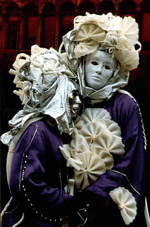
Farewell to Meat, Hello to Fantasy
(A very brief introduction to Carnevale traditions and history
for attendees of the GBACG Italian Carnivale Banquet)
Origins of Carnevale
Carnevale (or Carnivale, or Carnavale, alternate spellings you may find), is a festival which can trace its roots back to the Roman Saturnalia, a festival held in mid-December to honor the god Saturn with feasting, gift giving and role reversal. As often happened with such festivals, Catholics found a way to work the festival into their own liturgical year.
One commonly accepted derivation of the word “carnival” is the Latin “carne vale” or “farewell to meat.” Carnival was the final hurrah as winter headed towards spring, and the long Lenten season of fasting and abstinence. It was, perhaps, not only a last chance to indulge the passions of the flesh, but an opportunity to consume any meat which had been put up for winter that might not stay fresh enough for consumption until spring brought the end of Lent and Easter.
Because of its ties to the liturgical calendar, Carnivale varies in length. It can be considered to begin with the feast of Epiphany (the 12th day of Christmas) on January 6, and always ends on Shrove Tuesday, the day before Ash Wednesday, the first day of Lent. The Lenten season is the 40 days before Easter, which falls on the first Sunday after the first full moon after the vernal equinox.
Confused yet? Don’t worry about it. In 2003 Lent starts on Wednesday, March 5, which means the last day of Carnivale is Shrove Tuesday, March 4. (If you’ve never heard of Shrove Tuesday, perhaps you’ve heard of “Fat Tuesday” — also known in French as Mardi Gras, or in Italian as Martedi Grasso. Is it all becoming clear now?)
Carnivale is celebrated with enthusiasm around the world; in the US the celebration in New Orleans is best known. In Brazil, Carnivale in Rio is famous (or infamous) for its wild abandon. Many cities in Italy have maintained or revived their traditions of Carnivale; especially well-known among them are Venice and Florence.
While Carnivale has a rich history and ancient roots in Italy, the festival remains a vital and contemporary celebration. A simple web search will reveal many images of celebrants in both historical and contemporary costumes. One of the common elements found throughout the tradition has remained the Carnivale mask.
Masks and Mummery
Venice (and many Italian cities) in the Middle Ages and Renaissance had a long tradition of mask-wearing among the nobility while engaging in activities of a questionable nature — gambling, drinking, not to mention romantic and sexual rendezvous. Their activities were so outrageous that laws were passed to restrict the wearing of masks to certain times of year. One of those times was Carnivale.
Masks were also worn by the lower classes to allow them to mix unfettered with the aristocrats in such situations. The mask, after all, was a great equalizer in a social setting. This was especially common in Carnivale, with its traditions of role reversal and celebration of the fool.
One of the most common masked images of Venice and Carnivale is the Bautta — a costume consisting of a white mask called the volto which covers 1/2 to 3/4 of the face, worn with a voluminous black veil and/or cloak, topped with a black tricorn hat. The bautta is particularly popular because it permits eating, drinking (and kissing) while disguising the features.
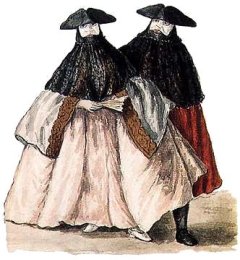
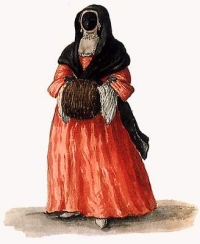
Another traditional mask, worn only by women (only by patrician women in the 18th century), is the moretta, a black oval mask that is held in place not with a band or string, but by a button on the inside of the mask that is held clenched between the teeth of the wearer.
Another popular traditional Carnivale role was the Gnaga — men dressed as women, “imitating their ways but using much more vulgar speech.” (In other words, what in the UK and US would be called “campy” drag.) Often the gnaghe (plural of gnaga) pretended to be nannies; they would therefore be accompanied by children or other grown men dressed as boys and girls — or even babes in diapers.
Cross-dress costumes are still very popular in the contemporary Carnivale celebrations.
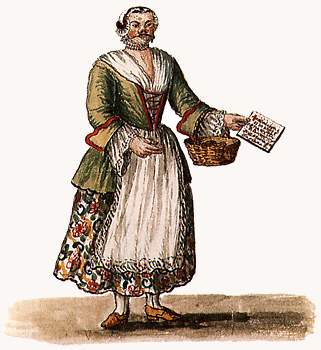
Many other costumes are taken from the commedia dell’arte — Arlecchino (Harlequin), Pantalone, Capitono, Brighella, Colombina, etc.
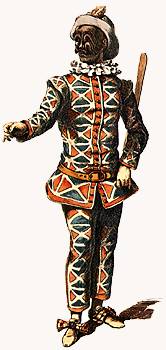
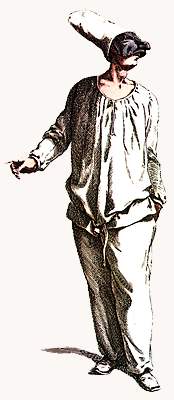
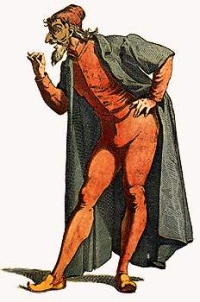
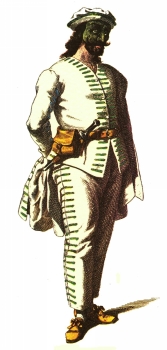
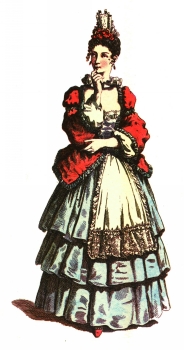
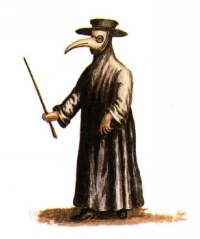
Another peculiarly popular and interesting character is “El Medico dea Peaste”, the Plague Doctor.
His costume originally served several functions — first, in the time of plague, it was a disguise to hide the identity of a physician who by visiting plague victims might be exposed to contagion. The tunic was of pure linen or waxed cloth to protect him, and finally, he always had his trusty staff with which he removed the clothes of plague-victims, thinking that in this way the terrible epidemic would not bring him any harm.
And of course, contemporary Carnivale-goers may occasionally break with tradition and do something more topical than time-tested.

Additional Resources
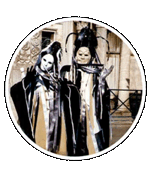
- The Portale de Venezia “Carnivale in Venice” Site
includes sections about both historical Carnivale and the contemporary celebration. (The illustrations on this page are from this site) - Carnevale, carnevale,CARNEVALE…
(another Italian site, be sure to use the right hand set of links to get the English pages) - Frannie Germeshausen’s Venice Photo Album
Frannie, the GBACG Events Coordinator, has posted a wonderful collection of photos from her trips to Venice and Carnivale. You’ll find many costume photos in particular on page 2 and pages 6-12. - Carnival of Venice site at delpiano.com
Another site featuring history, costumes and images from both period and contemporary Venetian Carnivale. (If you click on “Carnival Home” from this page, it takes you up to a portal with links to sites about Venice, Rio and San Francisco Carnivale celebrations. - Masks and Meanings in Tiepolo’s Venice, an essay by James Christen Steward
- Information and Ticket Sales for the GBACG Italian Carnivale Banquet
This is by no means a complete or rigorous examination of Carnivale and its traditions. It’s entirely possible I missed something important. If you spot such an omission, you can let me know at carnivale-page@twistedimage.com
Kevin Roche

